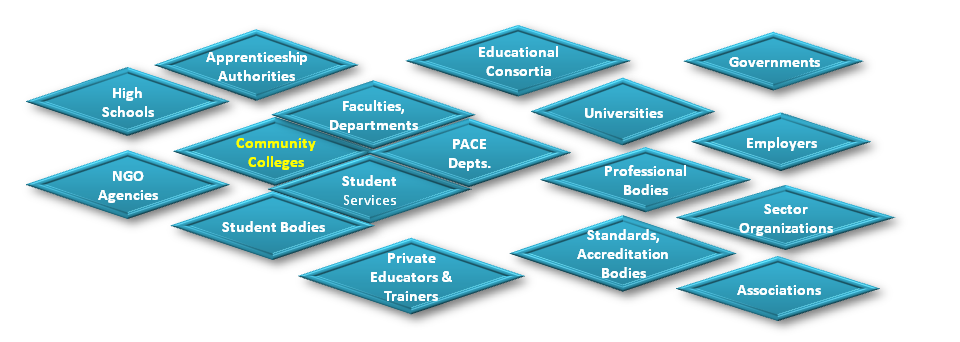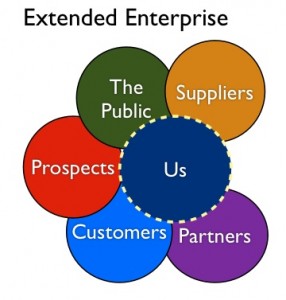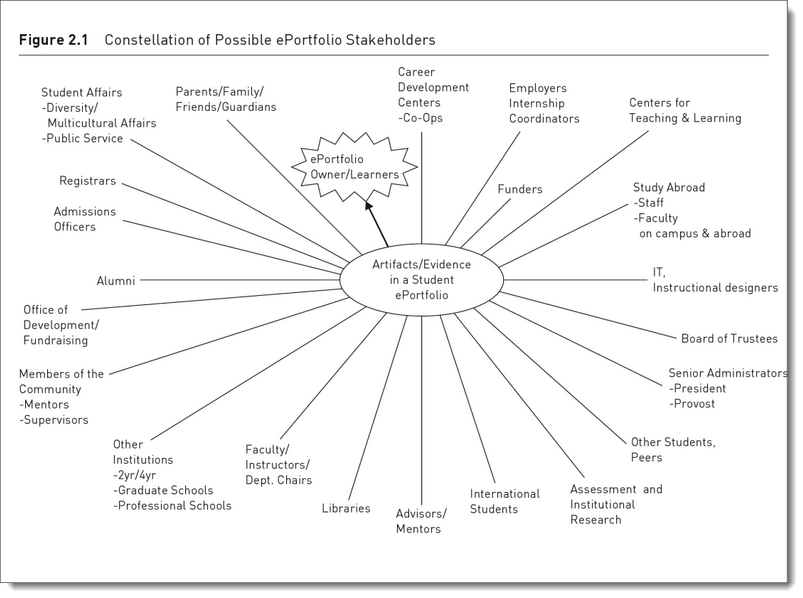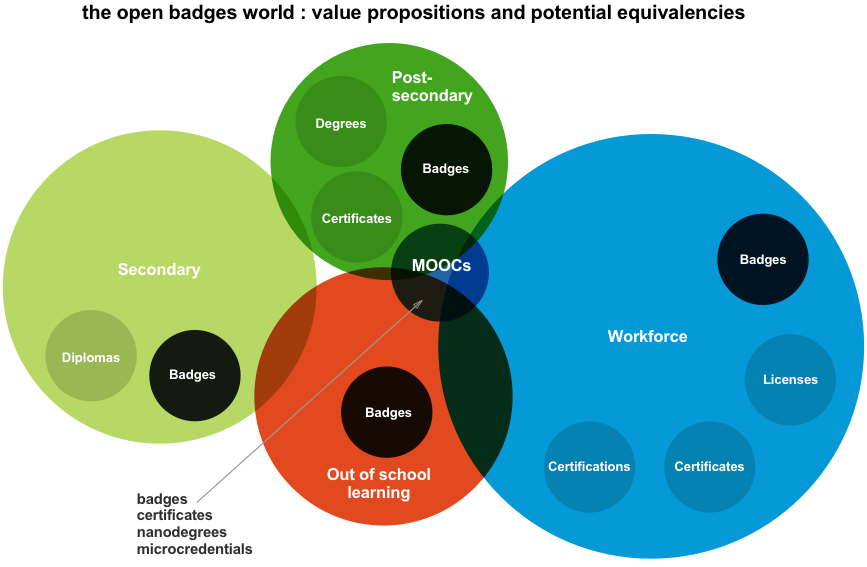I’ve been having a lot of fun over the last few weeks re-thinking how Open Badge eCredentials can enhance lifewide learning through the lens of Extended Enterprise Learning.
Although this concept originated as a form of “edu-marketing” for private sector producers of products and services, John Leh of Talented Learning has identified five sectors that significantly employ this kind of learning. These are listed below (the linked listings point to my previous posts on the topic):
- Private sector producers of products and services
Improving the product value chain: suppliers, distributors, retailers, customers - Member-based Organizations
Associations, Unions, Not For Profits - Academic institutions
Open Education, MOOCs, Work Integrated Learning, vocational education and Apprenticeship - Private Sector Educators and Trainers
B2B, B2C: independent trainers, ConEd business units - Public Sector organizations
Emergency/public awareness, voluntary sector support, armed forces, civilian public service
This post explores how academic institutions already deliver Extended Enterprise Learning and how they might do this more deliberately for their own survival in troubled times.
How Academic Institutions Align with Extended Enterprise Learning:
| Extended Enterprise Learning |
Academic Institution |
| Learning is delivered to non-employees: customers, partners and other stakeholders in the value chain | Learners, employers, sector bodies, professional bodies, accreditation bodies, governments, other institutions, contractors, SaaS |
| Learning is an optional, often paid service |
Undergraduate student engagement and retention ConEd, Contract Training |
| Delivery is diverse and spans contexts | F2F, asynchronous/synchronous online, credentialed/non-credentialed, coaching, mentoring, performance support Multiple partners |
| Learner is not necessarily identified | MOOCs, OER |
| Learning is a customer pipeline |
MOOCs, Open University’s Badged Open Courses |
| Learning is an after-market “value add” | Continuing Education, Continuing Professional Development |
| Learning provides added revenue | PACE as a revenue centre |
| Learners are brand advocates | Displaying credentials in résumés and on social media |
Mapping a Vision for Extended Enterprise Learning at Academic Institutions
The fourth diagram, an ugly one thrown together by me, is a conceptual mashup of the first three:
An Extended Enterprise Map by Jay Cross
An Academic Stakeholder Map
Academic institutions don’t only exist in ecosystems, they are ecosystems in themselves:
A Credentialing Map
This recent post from Carla Casilli, a thought leader in the Open Badge community, demonstrates the notional flexibility and hints at the portability of Open Badges:
Don’s Ugly “Shove-It-All-On-One-Page” Map
I’ve taken community colleges as an example key connector and deconstructed them a bit, so that cluster represents a sub-layer – I could just as easily have done that with universities:

Implication 1: Customer Diversity, Learner Autonomy
Many public sector academic institutions, particularly universities, are uncomfortable with the notion of learner as customer, preferring to think of them as what I would call “targets for transformation”, if teaching is the goal, or “talent pipelines” if research is the goal. OK, sometimes both.
However, Learners do generally pay for their learning, they generally have a choice of suppliers and do vote with their feet if their needs aren’t being met.
Certainly there are dangers inherent in treating undergraduate students too much like customers; ask any instructor whose performance assessment is based on student evaluations. But Gardner Campbell, Vice Provost for Learning Innovation and Student Success at Virginia Commonwealth University, warns us that there are also dangers inherent in viewing value only in terms of the institution. Student needs can be conflated with institutional needs and real learning can be compromised.
This can have an impact on about society and the concept of “shared private goods” (i.e. the shared learning of learners) contributing to the public good in what Gardner Campbell calls the “digital media commons”. See this recent interview excerpt from Bryan Alexander’s excellent Future Trends Forum series (watch 3m22s – 7m45):
[youtube https://www.youtube.com/watch?v=br4dJDJkNW4?t=3m22s%20rel=]
So maybe the public is a “customer”.
And there are other customers, such as:
- Employers
- Professional bodies
- Funders
Exploring the first element, “learner as customer” , we have the following examples of the “Extended Enterprise”:
- “Pre-Sales”: MOOCs as recruitment vehicles
MOOC consortia are proliferating. We’ve heard of edX, Coursera and even Unizin. Over in Europe, Open University’s multi-institutional multi-national FutureLearn platform has over 3.5 million learners. In the words of its CEO, MOOCs will become “one of the most important recruitment grounds…particularly for international students”, adding that their university partners were discovering that offering free online content was “not just about courses” but also about making institutions “more discoverable” online.
First sample is free…
- “Post-Sales”: Continuing Education, Continuing Professional Development, Alumni Associations
It’s useful to maintain contact with graduates (satisfied customers?), who may want to come back for more learning, or may wish to “pay back” their learning in the form of donations. Institutions can encourage this productive relationship by providing services for alumni such as, oh I don’t know, maybe a lifelong ePortfolio?
Implication 2: Competition and Coopetition
Yes, institutions compete with each other and the private sector competes with the public sector; I’ll be exploring Extended Enterprises in private sector education in a future post.
But each institution is part of a larger system whose goal is (should be!) to benefit learners as they move through the (more or less) defined stages of learning: K12, post-secondary, professional/post-graduate, workplace and lifelong. As the learner moves through the stages of their learning, the supplier and other stakeholders inter-operate (again, more or less).
Some examples:
- Articulation agreements and dual credit programs: secondary/post-secondary, college/university
- Apprenticeship Board agreements with colleges to provide the formal learning component of apprenticeship programs
- Agreements with employers for Work Integrated Learning and custom programs aligned to industry needs
- Undergraduate programs designed for professional certification
- Other external standards and accreditation bodies which help align learning standards and programs and hold providers accountable for quality of delivery. They are themselves accountable to the public and regulated by the governments (who are themselves accountable…)
- Recognition of Prior Learning enables learners to carry forward more of the human capital they have earned along the way, via credit transfer and prior learning assessment, including recognition of experiential learning. (It’s not always perfect – I went to three institutions before I got my undergraduate degree, leaving several orphaned credits in my wake…)
Implication 3: Small Pieces, Loosely Joined – Enabled by Portable Credentials
If the components of a system are smaller and based on common standards they can connect with each other more easily. David Weinberger tells us this is why the Internet is so revolutionary: HTTP, FTP, SMTP…
In this way, simplicity and modularity can support the flexible complexity of an ecosystem, rather than the brittle complications of trying to get vertically integrated information siloes to talk to each other.
Portable micro-credentials (small, standards-based) can help enable this. Here are some quick examples by topic:
- MOOCs
Badged Open Courses on OpenLearn, (Open University’s “Home” MOOC platform) are for “learners who are seeking access to study skills and to have their learning recognised.” According to their report, Badging and Employability at the Open University, “Evaluation of the OU’s pilot badging projects suggests that badging offers a way of reconciling informal learning and the demands of employers, and that badging content for university students and informal learners alike may become a key widening participation activity for HEIs.” - Co-Curricular Records and ePortfolios
Notre Dame’s E2B2 (ePortfolios with Evidence-Based Badges) initiative encourages students to showcase their skills and accomplishments visually on their ePortfolios, while establishing a standard system for verifying and quantifying these formal and informal achievements and skills. As students get involved with badges, the goal is that they start to focus on the co-curricular aspects of their education that is, the learning that happens outside of the classroom.
- Continuing Education and Alumni Professional Development
University of Central Florida’s Division of Continuing Education delivers both kinds of eCredentials, in addition to a host of others for undergraduates, staff and faculty. - Open Assessment
DeakinDigital‘s modular “Recognition of Professional Practice: micro-credentials for Graduate Learning Outcomes (Communication, etc.) aligned to the Australian Qualification Framework that can add up to 90+% of a Master’s Degree at a fraction of the time and cost. The customers for this “Credential-to-Degree”program can be Employers, who can cherry-pick for Talent Management programs, or individual Learners, who might never have gone back for traditional Masters degree, for reasons of time or expense.
In closing…
Imagine if this:
… were part of this:

The Opte Project CC-BY-2.5
… instead of this:

Photo via Good Free Photos – PUBLIC DOMAIN
Wouldn’t that be a good thing?
Not only for the learner, but for academic institutions seeking new routes to fiscal sustainability.
Current methods aren’t working too well for many institutions: since 2013, Bryan Alexander has been curating a scary list of institutional examples of what he calls the Queen Sacrifice: “the combination of self-destructive sacrifice and hope for gain” – otherwise known as cutting core programs to make ends meet and stay in business.



